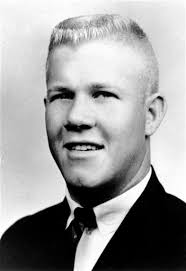In the middle of the night on August 1st, 1966, 26-year-old Charles Whitman sat down at his typewriter in his house and began typing a letter.
It begins:
“…I don’t really understand myself these days. I am supposed to be an average reasonable and intelligent young man. However, lately (I don’t recall when it started) I have been a victim of very unusual and irrational thoughts.” Later that night, Whitman drove to his mother’s house and killed her. Before leaving, he wrote a note and left it next to her on the bed:
“TO WHOM IT MAY CONCERN,
I’ve just taken my mother’s life. I am very upset over having done it. However I feel that if there is a heaven she is definitely there now…”
Later that night Whitman murdered his young wife, Kathy, while she lay sleeping in bed. He stabbed her numerous times in the chest. Before he did this he wrote another letter…“…It was after much thought that I decided to kill my wife, Kathy, tonight after I pick her up from work at the telephone company. I love her dearly, and she has been as fine a wife to me as any man could ever hope to have. I cannot rationally pinpoint any specific reason for doing this.” (Austin History Centre)
Later that day Whitman drove to the University of Texas at Austin campus, where he was a student. He had packed a huge case filled with guns, ammunition, food, water and enough supplies to last for a few days. He climbed to the top of the observation tower that looks out over the campus and the city. Whitman killed the receptionist with the butt of a rifle. He then set up his sniper rifle on the tower and began taking aim at innocent people as they walked around the campus.
In two hours of what must have been horrific terror for the people of Austin, Whitman killed 14 people, and injured over 30 others.
What are your thoughts when you hear the story of Charles Whitman?
Whitman’s case was and still is a mystery, like many murderers and serial killers who seem to kill without reason. But your job as a psychologist isn’t necessarily to judge people’s behaviour, it’s to investigate the research in order to understand it. In this chapter you are going to be introduced to the fascinating subject of psychology by looking at criminal behaviour.

Charlest Whitman: a seemingly normal man who shot 14 people dead in 1961. (from wikicommons)
In understanding how and why people behave and think the way they do, we have to consider multiple factors – including biological, environmental, cultural and social influences. By the end of this unit you’re going to be challenged to answer this question: How might a variation of the MAOA gene increase the likelihood of someone reacting aggressively in a socially threatening situation?
Our Criminology unit provides teachers and students a chance to explore the fascinating study of understanding criminal behaviour, including its origins, effects and possible solutions. This unit aims to provide students with an introduction to the study of psychology by introducing the three approaches in one unit. While the primary focus will be on the biological bases of violent crime and antisocial behaviour (e.g. testosterone, serotonin, the role of the prefrontal cortex and the amydala), other variables are not ignored. The role of thinking and decision making and its connections with the prefrontal cortex is a recurring theme, as is the role of the amygala and emotion. The culture of honour studies and Bandura’s Social Cognitive Theory are introduced to provide an introduction to the idea that social and cultural factors may also play a prominent role in explaining the origins of criminal behaviour.
This unit covers the major outcomes of the biological approach (except only pheromones), while introducing students to a much wider range of concepts.
Travis Dixon is an IB Psychology teacher, author, workshop leader, examiner and IA moderator.